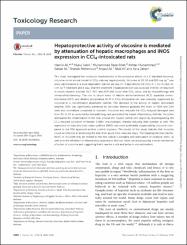| dc.contributor.author | Ali, Hamid | |
| dc.contributor.author | Kabir, Nurul | |
| dc.contributor.author | Shah, Muhammad Raza | |
| dc.contributor.author | Muhammad, Akhtar | |
| dc.contributor.author | Ali, Safdar | |
| dc.contributor.author | Mehmood, Shahab | |
| dc.contributor.author | Jahan, Azra | |
| dc.date.accessioned | 2020-11-20T15:03:12Z | |
| dc.date.available | 2020-11-20T15:03:12Z | |
| dc.date.issued | 2016 | |
| dc.identifier.issn | 2045-452X | |
| dc.identifier.issn | 2045-4538 | |
| dc.identifier.uri | https://doi.org/10.1039/c6tx00165c | |
| dc.identifier.uri | https://hdl.handle.net/20.500.12809/2683 | |
| dc.description | WOS: 000387013300019 | en_US |
| dc.description | PubMed ID: 30090468 | en_US |
| dc.description.abstract | This study investigated the molecular mechanism(s) of the protective effects of a C-alkylated flavonoid, viscosine on an animal model of CCl4-induced hepatotoxicity. Viscosine at 20, 50 and 100 mg kg(-1) was orally administered in a dose dependent manner per day for 3 days before the CCl4 (1 : 1 v/v in olive oil, 1 ml kg(-1)) treatment and 2 days after the treatment. Hepatoprotection was assessed in terms of reduction in serum enzyme activities (ALT, AST, and ALP) that occur after CCl4 injury, and by histopathology and immunohistochemistry. The rise in serum levels of alanine aminotransferase (ALT), aspartate aminotransferase (AST), and alkaline phosphatase (ALP) in CCl4-intoxicated rats was markedly suppressed by viscosine in a concentration dependent manner. The decrease in the activity of hepatic antioxidant enzyme, SOD, was significantly prevented by viscosine, likewise gradually the levels of MDA and GSH were also normalized compared to silymarin. Viscosine also reduced the CCl4-induced damaged area from 2% to 0% as assessed by histopathology and prevented the mixed inflammatory infiltrate. Viscosine attenuated the inflammation in the liver around the injured central vein region by downregulating the CCl4 induced activation of hepatic CD68+ macrophages, thereby reducing their number as well. The expression of inducible nitric oxide synthase (iNOS) was more potentially suppressed by viscosine compared to the FDA approved positive control silymarin. The results of this study indicate that viscosine could be effective in protecting the liver from acute CCl4-induced injury. The hepatoprotective mechanisms of viscosine may be related to the free radical scavenging and attenuation of oxidative stress, as well as to the inhibition of inflammatory response in the liver. Here, we are proposing a novel mechanism of action of viscosine and suggesting that it may be a safe and better in vivo antioxidant. | en_US |
| dc.item-language.iso | eng | en_US |
| dc.publisher | Oxford Univ Press | en_US |
| dc.item-rights | info:eu-repo/semantics/openAccess | en_US |
| dc.subject | Hepatic macrophages | en_US |
| dc.title | Hepatoprotective activity of viscosine is mediated by attenuation of hepatic macrophages and iNOS expression in CCl4-intoxicated rats | en_US |
| dc.item-type | article | en_US |
| dc.contributor.department | MÜ, Fen Fakültesi, Kimya Bölümü | en_US |
| dc.contributor.institutionauthor | Muhammad, Akhtar | |
| dc.identifier.doi | 10.1039/c6tx00165c | |
| dc.identifier.volume | 5 | en_US |
| dc.identifier.issue | 6 | en_US |
| dc.identifier.startpage | 1688 | en_US |
| dc.identifier.endpage | 1698 | en_US |
| dc.relation.journal | Toxicology Research | en_US |
| dc.relation.publicationcategory | Makale - Uluslararası Hakemli Dergi - Kurum Öğretim Elemanı | en_US |


















